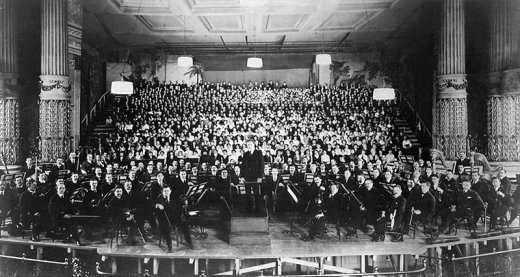
BACK IN THE DAY: Philadelphia Orchestra, March 2nd, 1916
![]() BY DAVE ALLEN I though that jeans and an untucked dress shirt might fly at a new-music event: the kickoff concert for Orchestra 2001’s 20th-anniversary season, held at the Perelman Theater on Friday. Nope. Suits and ties ruled the night, even by the few age-group peers in the crowd (I later found out they were students of one of the evening’s performers). But no matter: even if formality held sway in the audience, the evening’s program, including two world premieres, was bound to shake things up. The concert opened with a tense, nerve-wracking scene from an operetta by Ronald Vigue. “Tides” had the flavor of avant-garde theater, with soprano Ann Crumb pacing, leafing through a magazine, and all but coming apart at the seams as she waits in an airport. The tension in Vigue’s music, heard in fractured bits of woodwind melodies and darkly throbbing strings, reinforced the tension felt in the scene and the audience: the idea that we were eavesdropping on a private moment, one that we’re not meant to witness.
BY DAVE ALLEN I though that jeans and an untucked dress shirt might fly at a new-music event: the kickoff concert for Orchestra 2001’s 20th-anniversary season, held at the Perelman Theater on Friday. Nope. Suits and ties ruled the night, even by the few age-group peers in the crowd (I later found out they were students of one of the evening’s performers). But no matter: even if formality held sway in the audience, the evening’s program, including two world premieres, was bound to shake things up. The concert opened with a tense, nerve-wracking scene from an operetta by Ronald Vigue. “Tides” had the flavor of avant-garde theater, with soprano Ann Crumb pacing, leafing through a magazine, and all but coming apart at the seams as she waits in an airport. The tension in Vigue’s music, heard in fractured bits of woodwind melodies and darkly throbbing strings, reinforced the tension felt in the scene and the audience: the idea that we were eavesdropping on a private moment, one that we’re not meant to witness.
The other work with its ink still wet came from Penn professor and new music luminary George Crumb: the latest volume in his decade-long American Songbook project. Like the other entries in Crumb’s songbook, “Voices from the Morning of the Earth” recasts folk songs and divorces them from their roots. The texts, sung by Crumb and baritone Randall Scarlatta, drew from the hollers of West Virginia, the lonesome high plains of Wyoming, and an eccentric folkie from Hibbing, Minnesota, whom you might have heard of. Backed by an amplified piano and an orchestra of percussion – steel drums, marimbas, chimes, all manner of Latin-style drums, and more – the song settings ranged from tragically hush (“Put My Little Shoes Away”) to grating (the bombastic “When the Saints Go Marching In”) to mistily gorgeous (“A Mountaineer’s Sad Song”). Two staples of ’60’s-era protest music — Pete Seeger’s “Where Have All the Flowers Gone?” and the Bard of Hibbing’s “Blowin’ in the Wind” — received double-take-inducing treatments. For all the dissonance and dynamic extremes of Crumb’s music, though, they’re simpler than they seem. He sets basic pentatonic melodies, common to both American folk tunes and traditional Asian music, to movement at different speeds and sometimes in two keys at once. This technique, combined with his fondness for ringing timbres (all those cymbals and gongs!), doesn’t always play lightly on the ears, but whether loud or soft, the music aims straight for the solar plexus.
The Saturday night program for the Philly Orchestra, who play in the bigger room just a few yards from the Perelman, was older but no less incisive. The Orchestra reprised their Thursday night program — minus a dissonant, sneering Shostakovich piece (can’t have steely modernism turning patrons’ stomachs) — with pianist Martha Argerich, a world-class soloist, but a reclusive, press-shy one. Put simply, she played the hell out of the Prokofiev piano concerto, dishing out both rapid passages and thundering bass notes with the ease of a grocery clerk making change. The orchestra was pretty subdued in backing her up, but on two works by Ravel — Valses nobles and sentimentales and his orchestration of Musorgsky’s Pictures at an Exhibition — they cut loose, bringing warmth and precision to Valses and a brawny, schizophrenic character to Pictures. My dress was, once again, casual (I had a meeting earlier that afternoon with The Boss and couldn’t find time to change), and the sight of row upon row of evening gowns and tuxes was certainly daunting. But if you’re a young person at a classical event in this city, it doesn’t matter what you wear, just as long as you are there.
